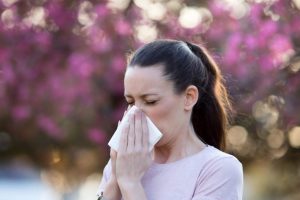As temperatures rise and more people seek comfort in air-conditioned homes, indoor allergies can quickly become a silent disruptor. While escaping the outdoor heat might sound like a relief, the allergens lurking inside our homes can be just as frustrating—causing symptoms that mimic seasonal illnesses and impacting quality of life.
According to Dr. Stephen Cooper, a board-certified otolaryngologist with Bayhealth ENT, understanding your indoor environment and taking preventive measures is the key to reducing allergy symptoms. Here’s everything you need to know to win the battle against indoor allergies.

Understanding Indoor Allergies: More Than Just a Seasonal Nuisance
Unlike seasonal allergies, which flare up in spring or fall due to pollen, indoor allergies persist year-round and are often caused by dust mites, pet dander, mold spores, and cockroach droppings. These allergens accumulate inside your home, especially in fabric-covered surfaces like carpets, furniture, curtains, and bedding.
Common Indoor Allergy Symptoms Include:
-
Sneezing or nasal congestion
-
Runny or itchy nose
-
Itchy, watery, or red eyes
-
Persistent cough
-
Sinus pressure or headaches
-
Wheezing, chest tightness, or shortness of breath
If these symptoms sound familiar and don’t resolve with the seasons, there’s a good chance indoor allergens are the culprit.
The Main Culprits: Dust Mites and Pet Dander
Dust Mites: The Invisible Irritants
Dust mites are microscopic organisms that thrive in warm, humid environments and feed on dead skin cells. They’re commonly found in:
-
Bedding
-
Pillows and mattresses
-
Upholstered furniture
-
Carpets
-
Curtains
According to Dr. Cooper, dust mite allergy symptoms can peak in late summer, making that season particularly troublesome for sufferers.
How to Combat Dust Mites:
-
Use allergen-proof pillow and mattress encasements.
-
Wash bedding weekly in hot water (130°F or higher).
-
Vacuum with a HEPA filter-equipped vacuum.
-
Avoid wall-to-wall carpeting, especially in bedrooms.
-
Dehumidify your home to keep humidity below 50%.
Pet Dander: A Common Household Trigger
Pet dander, made up of tiny flakes of skin shed by cats, dogs, and other furry animals, is another major trigger for indoor allergies. Even homes without pets can harbor pet allergens due to transfer on clothing.
Pet Dander Prevention Tips:
-
Keep pets out of the bedroom to maintain an allergen-free zone.
-
Bathe and groom pets regularly to reduce dander.
-
Use air purifiers with HEPA filters to trap airborne allergens.
-
Wash pet bedding and toys frequently.
Cleaning Tips to Keep Allergens at Bay
Dr. Cooper emphasizes that routine, thorough cleaning is essential in reducing exposure to indoor allergens.
Weekly Cleaning Checklist:
-
Vacuum carpets, rugs, and furniture with a HEPA vacuum.
-
Wash or replace curtains with allergy-friendly alternatives.
-
Clean or replace HVAC filters monthly.
-
Use damp cloths to dust instead of dry ones to prevent allergens from becoming airborne.
-
Wash soft toys, throws, and pillow covers frequently.
By maintaining a consistent cleaning routine, you can significantly lower allergen levels in your home.
Medication Options for Indoor Allergy Relief
While environmental control is the first line of defense, medications can offer symptom relief—especially during flare-ups.
Over-the-Counter Antihistamines:
-
Claritin (loratadine)
-
Zyrtec (cetirizine)
-
Allegra (fexofenadine)
-
Xyzal (levocetirizine)
These help alleviate sneezing, itching, and runny nose without causing drowsiness in most people.
Steroid Nasal Sprays:
-
Flonase (fluticasone)
-
Nasacort (triamcinolone)
-
Nasonex (mometasone)
Nasal sprays help reduce inflammation in the nasal passages. According to Dr. Cooper, these sprays must be used daily for consistent benefit—not just when symptoms appear.
When to See a Specialist
If your symptoms persist despite home treatment, it may be time to consult with an ENT (ear, nose, and throat) specialist or allergist. A professional evaluation can:
-
Identify your specific allergens through skin or blood tests.
-
Provide prescription medication or allergy shots (immunotherapy).
-
Help you develop a personalized treatment plan.
Frequently Asked Questions:
What is the difference between indoor and seasonal allergies?
Indoor allergies are triggered by allergens like dust mites and pet dander and persist year-round, while seasonal allergies are caused by outdoor allergens like pollen.
How can I tell if my allergies are due to dust mites?
If your symptoms worsen at night or after spending time indoors—especially in the bedroom—you may be reacting to dust mites.
Can indoor allergies trigger asthma?
Yes, indoor allergens can trigger asthma symptoms such as wheezing, coughing, and chest tightness, particularly in sensitive individuals.
Are air purifiers helpful for indoor allergies?
Yes, HEPA air purifiers can trap dust, dander, and mold spores, reducing the concentration of allergens in your indoor environment.
How long should I use a nasal spray for allergies?
Steroid nasal sprays should be used daily and consistently, not just during flare-ups, to experience full symptom relief.




